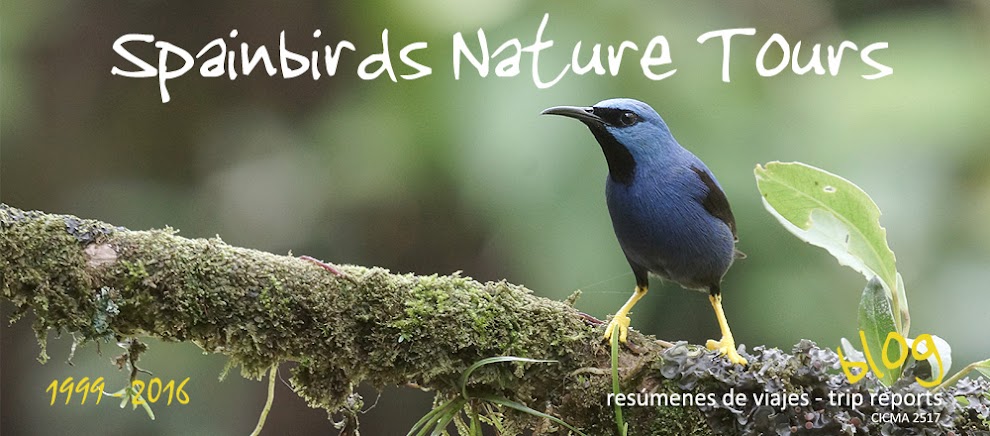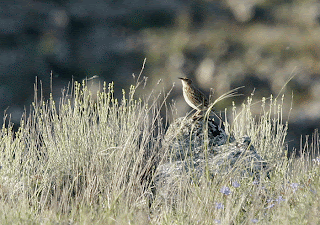Pocas oportunidades tiene uno (a pesar de pasar media vida en la carretera) de visitar en tan poco tiempo el Parque Nacional de Doñana, el Parque Nacional de Monfragüe, los Llanos cacereños, Gredos, la Montaña Palentina, el Parque Nacional de Picos de Europa, las marismas de Santoña, el Parque Natural de los Pirineos Occidentales y las estepas del Campo de Belchite... En estas dos semanas un grupo de 14 viajeros y 2 guías recorrimos todos estos lugares en un viaje organizado por la compañía americana Victor Emmanuel Nature Tours y Spainbirds. El balance arrojó un total de 207 especies de aves registradas (4 de ellas únicamente oídas), y 7 de mamíferos.
La primera parte del viaje, en el sur, tuvimos bastante dificultades para localizar algunas de las especies más emblemáticas, como el alzacola (visto únicamente fuzgamente) o la focha cornuda (ninguna en los lugares donde no suele fallar en anteriores ocasiones). También nos dio esquinazo la malvasía y el mosquitero ibérico, además de la cerceta pardilla, con la que ya prácticamente contábamos teniendo en cuenta lo poco que había llovido hasta ese momento. Sin embargo sí anotamos chotacabras cuellirrojo, avetorillo, garcilla cangrejera, alcaraván, gaviota de Audouin y multitud de limícolas.
En Extremadura mezcla de lluvia, viento y cielos despejados. Aquí sí que vimos todo lo importante incluyendo las cinco especies de águilas ibéricas, buitre negro, alimoche, curruca mirlona, cigüeña negra, collalba negra, vencejo real, avutarda, sisón, críalo, ganga ibérica, ganga ortega, aguilucho cenizo, carraca, collalba rubia... a pesar de estar durante más de dos horas en el castillo de Monfragüe la primera tarde no vimos vencejo cafre, pero a la mañana siguiente uno de los clientes sí pudo observarlo.
El día completo en Gredos, desapacible, una vez más. A pesar del viento y el frío vimos bien pechiazul, verderón serrano, escribano hortelano (al menos 20 aves en un bando mixto con montesinos), bisbitas campestre y alpino, chova piquirroja, pero nos faltó el roquero rojo, que sorprendentemente no veríamos en todo el viaje.
Ya en Fuentes Carrionas no faltaron a su cita camachuelos, bisbitas arbóreos, escribanos cerillos... un día de transición hacia Picos de Europa. En las zonas bajas del valle de Liébana fantásticas observaciones de pico mediano, alcaudón dorsirrojo, colirrojo real, torcecuello... y en Fuente De una cantidad de nieve como nunca había visto en estas fechas. No pudimos llegar al sitio tradicional de los treparricos porque el camino se hallaba impracticable pero al menos vimos gorrión alpino, acentor alpino y dos treparriscos de pasada, aunque bien observados.
Viaje largo hacia Pirineos haciendo parada en Santoña, donde no vimos gran cosa pero añadimos a nuestra estornino pinto, para algarabía de los participantes... Tanto en Picos como en Pirineos tuvimos el mejor clima del viaje, a excepción de la incursión a tierras francesas en el alto de Sant-jean-piede-port donde nos recibió la niebla y tuvimos que desistir de ver mirlo capiblanco. Sin embargo los días en Pirineos nos ofrecieron excelentes avistamientos de treparricos (donde localizamos un nido con aves supuestamente cebando pollos), picamaderos negro, quebrantahuesos, verderón serrano, águila real, escribano cerillo, curruca mosquitera, carbonero palustre...
Nuestro último día completo fue largo e intenso. Comenzamos a las 5:30 am saliendo de Valle de Hecho para llegar sobre las 8:30 a Belchite. Aquí no tardamos en localizar al menos dos alondras de Dupont, en vuelo y posadas... cuánta presión se quita uno cuando consigue verla. Entre otras especies interesantes en Belchite vimos terreras común y marismeña, criálo y ganga ibérica. Llegamos a Madrid esa misma tarde donde dimos por concluido el pajareo. El viaje finalizó al día siguiente llevando a los clientes al aeropuerto.
La aldea de El Rocio / El Rocío village
Garceta grande / Great Egret
Águila imperial en Monfragüe / Spanish Imperial Eagle in Monfragüe
Carraca / European Roller - Llanos de Cáceres
Culebrera europea / Short-toed Eagle
Gorrión moruno / Spanish Sparrow
Cigüeña negra / Black Stork
Golondrina dáurica / Red-rumped Swallow
Alimoche común / Egyptian Vulture
Pollo de búho real / Eagle Owl chick - Monfragüe
Escribano montesino / Rock Bunting - Gredos
Alcaudón dorsirrojo / Red-backed Shrike - Picos
Pico mediano / Middle Spotted Woodpecker - Picos
Chova piquigualda / Alpine Chough - Picos
Torcecuello / Wryneck - Picos
Treparricos / Wallcreeper - Pyrenees
Treparricos / Wallcreeper - Pyrenees
Treparricos / Wallcreeper - Pyrenees
Picamaderos negro / Black Woodpecker - Pyrenees
Quebrantahuesos / Lammergeier - Pyrenees
Marmota / Marmot - Pyrenees
From the horse-centric, sandy-streeted El Rocío, and Doñana National Park with its spoonbills and flamingos, to the wide open expanses of Extremadura with its bustards on the Caceres Plains, and the soaring heights of the three mountain ranges, we experienced Spain’s diversity in our 3,407 kilometer exploration of this great country. Lammergeier, Wallcreeper, Greater Flamingo, Black Woodpecker, Spanish Eagle, and Eurasian Eagle-Owl are some of the stunning birds we found while traipsing across Spain. The most enduring sound we heard was that of the cuckoo, heard all over the country. Tapas, wine, charming mountain villages, Spanish Civil War ruins, and exceptional hospitality were all enjoyed as well.
As we pulled into the charming El Rocío, our eyes were glued on the Madre de las Marismas lagoon bordering the south side of town. It was covered with waders, shorebirds, and ducks. Perhaps most coveted of the first bunch of birds were the Greater Flamingos, nearly 300 of the rosy birds feeding with their heads upside down. An elusive Little Bittern and Purple Heron would have to wait for everyone to get a look. Purple Swamphen, Common Pochard, Eurasian Spoonbill, Curlew Sandpiper, Pied Avocet, and Black-winged Stilt were also patrolling the lagoon.
The next day we discovered a dry Doñana; where verdant marshes should have been, there was seared ground. Spain was in the midst of its worst drought in 70 years. We did find most of the expected species, but in small numbers. Little and Great Crested grebes, Squacco Heron, Purple Heron, and Whiskered Terns were all accounted for. One of the drying ponds hosted hundreds of Common Ringed Plovers and a couple of Kentish Plovers. In the agricultural lands surrounding the national park we found plenty of birds. Larks and raptors were most obvious. Black Kites, Booted and Short-toed eagles, Red Kite, and kestrels of two species were all seen. The nesting White Storks on the old smokestack at Villamanrique were some of the more scenic we observed. Near the bustling port city of Huelva the salt marshes were full of birds. With a backdrop of giant tankers in the port, we watched Eurasian Oystercatcher, Eurasian Curlew, Whimbrel, Bar-tailed Godwit, Collared Pratincole, Audouin’s Gull, Little Tern, and Eurasian Marsh Harrier to name a few. A pair of Stone Curlews was a good find, but elusive.
Too soon it was time to depart El Rocío and head north to our next adventure in Extremadura. Monfragüe National Park is home to many raptors. The nesting cliffs at Salto del Gitano and La Portilla held Spanish Eagles, eagle-owl chicks, hundreds of Griffons, Black Stork, and even a Peregrine Falcon. The cork oak woodland was home to new birds as well—Mistle Thrush, Great Spotted Woodpecker, Azure-winged Magpie, bee-eaters, and Rock Petronia among them. Out in the wide open Caceres Plains we were treated to nice looks at Pin-tailed Sandgrouse, Great Bustard, displaying Little Bustard, Roller, Montagu’s Harrier, Cinereous Vulture, and a Black-bellied Sandgrouse pair (thanks Spike). Lunch in the town Square of Trujillo, Pizarro‘s birthplace, was excellent. Certainly the best wine of the tour was for celebrating Ron’s birthday May 5th; my favorite was Azpilicuetarioja 2008 (thanks Leonie).
The Gredos Mountains were our next stop. Alfonso and his wife fed us supremely as we enjoyed the wonderful snow-capped mountain scenery. The Bluethroat was not terribly cooperative, but we glimpsed him several times, while Spanish ibex roamed the forbidding cloud-swept ridges above us.
Due to the misty weather a wayward migrant flock of Rock and Ortolan buntings entertained us lower down the valley. Along the rocky stream at the Plataforma de Gredos, a cooperative White-throated Dipper posed on a boulder, blinking its white eyelids for us. Finches were common in Gredos, with Red Crossbill and the rare Citril Finch noted.
One luxurious night at the Parador de Cervera, with its wonderful food and wine, was enough to tempt some folks into dreaming up a Parador birding tour of Spain! After departing the Parador we visited an ancient Romanesque church at San Salvador de Cantamuda dating from the 12th century. Our first vista to the Picos de Europa from Piedrasluengas Pass was exceptional; the jagged rocky peaks, still snow-covered, left us in awe. We descended into the Potes Valley through beautiful oak and beech forest just starting to break bud. In the afternoon we visited some charming villages; one hosted a nesting Middle-spotted Woodpecker, a disappointed fox, and a disheveled chicken; the other a beautiful pair of Red-backed Shrikes. The cable car is an easy way to get high elevation species without a day of climbing. We rocketed up, and in three minutes we were in a barren alpine land.
Yellow-billed Choughs were the first to greet us. Some intrepid folks hiked over the snow to find a distant Wallcreeper, White-winged Snowfinch, and Alpine Accentor. On the way back a more cooperative male Snowfinch allowed for scope views. Lounging about on the snow and feeding on the meager vegetation were chamois. Lower down, in yet another cute village, a pair of Wrynecks entertained us for a quarter-hour, convinced we couldn’t see them.
Our next mountain range would be the Pyrenees. As the Gredos and Picos before them, the Pyrenees were spectacular and snow-covered. The river at the bottom of the Boca del Infierno raged with angry red water from the snowmelt. The mountain scenery was perhaps our best of the trip, and the rushing streams of the Hecho and Anso valleys were incomparable. A short hike led us to Salto de la Vieja and a nesting pair of Wallcreepers. They returned to the crevice several times, presumably feeding young.
We watched them creep and flick their wings open on the sheer face before us. Their crimson and black wings carried them out of sight eventually. From the Hotel Uson parking lot a distant pair of Lammergeiers was observed. The next day a pair was seen repeatedly dropping bones along a mountain ridge; unconcerned Alpine marmots chased around in the meadow below. In the forest a Black Woodpecker made a couple of appearances and obliged with scope views. A Firecrest finally revealed itself too.
Our last day would carry us from the Pyrenees to the Belchite Steppe and on to Madrid. An early start would allow us to bird the steppe before the heat and wind became too bad. A quick breakfast in Fuendetodos, the birthplace of Goya, was all we had time for. Belchite Steppe, the dry grassland that hosts eight species of larks, was alive with song. Skylark, Lesser and Greater Short-toed, Crested, and Calandra larks were all belting out song. The Dupont’s would sing occasionally, only to leave us scratching our heads—where did the song come from? Finally, Santi spotted a skylarking Dupont’s Lark and some folks got on it in the clear blue sky. After watching this bird for several minutes, it made a dive into the cover of the steppe. We walked over to this area and were eventually rewarded with good scope views of a couple of singing birds, one of Europe’s rarest. One last cortado stop on the road to Madrid culminated in a wonderful tour of a diverse country. We saw and heard 208 species of birds in two weeks and had some wonderful dining and wining experiences.
I hope everyone enjoyed Spain. Thanks for traveling with VENT.
Text by VENT leader Brian Gibbons
























































